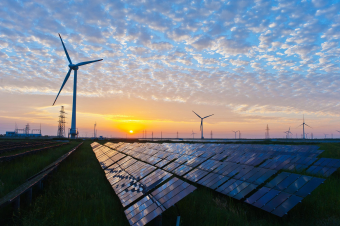
Every year, the California Energy Commission releases its Renewable Portfolio Standard (RPS) report, which gives details about the mix of energy experienced by all utilities within the state during the preceding 12 months. The report for this year, released in November, shows that all three of the state’s investor-owned utilities — Pacific Gas & Electric, Southern California Edison, and San Diego Gas & Electric — are projected to derive 50% of their electricity from renewable sources by 2020. That is a full decade ahead of schedule. PG&E reports it used 32.9% renewable energy in the past year. The figure for SoCal Edison was 28.2%. San Diego Gas & Electric led the pack with 43.2% renewable energy.
California’s governor Jerry Brown has been a tireless advocate for renewable energy but his predecessor, Arnold Schwarzenegger, was the first to make California’s renewable energy goals an official part of state policy in 2002. “We’ve got to realize that we are here today because of oil — oil and gas, to a lesser extent, coal,” Brown said when announcing the 50% renewable goal in 2015. At that time, he noted that California still produces more oil than any other US state except for Texas and North Dakota. “What has been the source of our prosperity has become the source of our ultimate destruction, if we don’t get off of it,” he added. That is a point that the current US administration seems incapable of recognizing.
When Schwarzenegger began the state’s renewable energy push, state Republicans screamed that it would strangle job growth and force electricity customers to pay higher utility bills. In fact, the opposite has occurred. California has created a boom in construction jobs in the solar and wind power sectors. The price of solar power has plunged from $136 per MWh in 2008 to $30 per MWh today. Wind power costs have fallen from $97 per MWh in 2007 to under $51 per MWh.
For those who say government shouldn’t stick its nose into business decisions — that would be everyone in the Trump administration, Fox News, and the 4,672 special interest groups funded by the fossil fuel industry — Brown has some thoughts. “People want to cast it as a choice between policy or technology as a solution but those should exist hand-in-hand. We would have never gotten renewable energy prices where they are today without really ambitious public policy. It shows the importance of bold goals,” Brown says.
“When you put a marker way out there and say, ‘We’re going to go achieve that, we’re going to write this down as a matter of policy and then go do it,’ you can accomplish an enormous amount. When you get it right, it’s this virtuous cycle where policy improves technology and that allows us to go for greater ambition without increasing prices and continuing to reduce unintended consequences.”
Now that the 50% goal is within reach, California is looking ahead to its next milestone — 80% renewables by 2050. “Once we get to about 50 percent, we’re going to start to run into new challenges — the second 50 percent will be trickier than the first 50 percent,” Brown notes. Part of the challenge will be balancing the grid using new technologies to avoid the need for fossil fueled “peaker plants” to provide additional electricity when demand is high.
Grid-scale battery storage is ideal for some situations but still too expensive for wide-scale use. “Storage is probably not the first option you want to talk about when you discuss grid integration just because batteries are still pretty expensive compared to other technologies,” Brown says. As an alternative, he recommends other strategies that may be more cost effective, such as pre-cooling buildings during times when there is low demand for electricity and increasing the interoperability of the grid.
“We have an interconnected grid, so I think it would have been foolish to say, ‘It all has to be done in California,’” Brown says. “One of the benefits of the grid is that we’re able to trade power — bring hydro down from the Northwest, bring wind in from Wyoming. These are all really good things. When you look at it, storage works, but it’s probably the last thing in the stack that we want to go to.”
Is 100% renewable power a possibility? Brown thinks it is, but that it’s not the most important thing to focus on. “I think of 100% as a bit of a red herring. If you want 100%, it should be 100% zero carbon electricity. Climate change is the existential threat and I don’t want to waste time arguing about what’s renewable or not. You have to get the carbon out of the energy system as quickly as possible.”
Statements like that make it clear that America has chosen the worst possible leader at the worst possible time. It is an open question how long progressive states like California will deem it in their best interest to support a union in which so many other states are intent on returning to the feudal practices of the Middle Ages.
Source: cleantechnica.com





